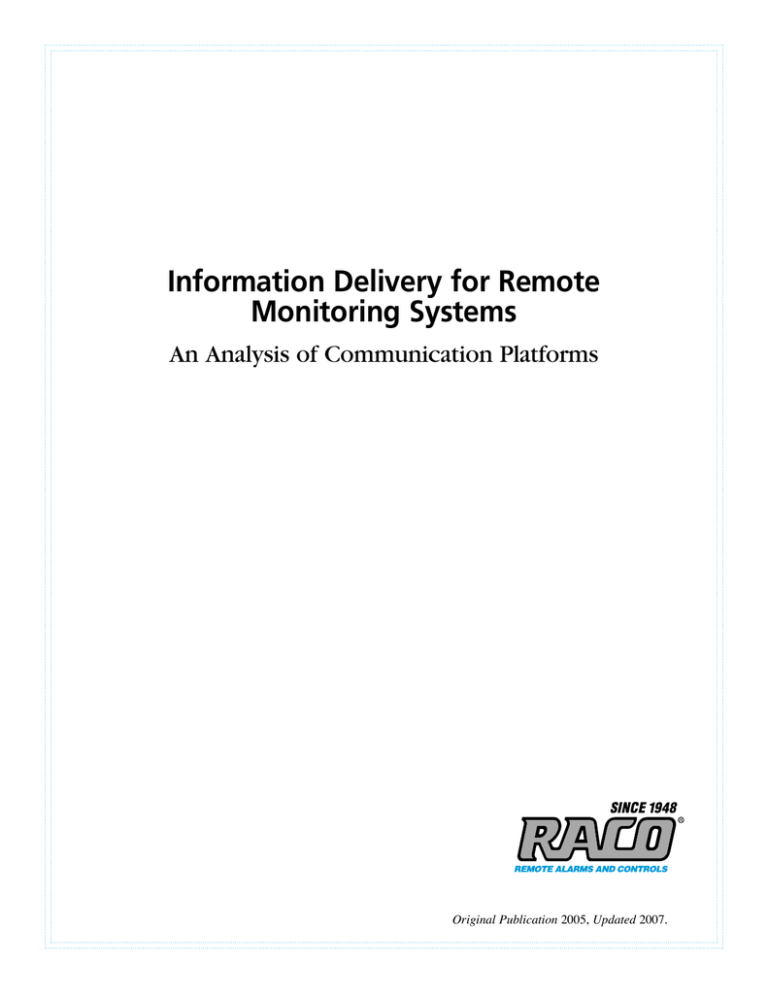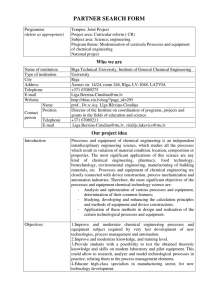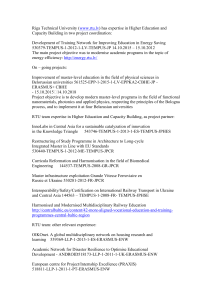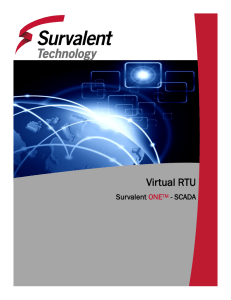
Information Delivery for Remote
Monitoring Systems
An Analysis of Communication Platforms
Original Publication 2005, Updated 2007.
Information Delivery:
Choosing the Right Communication Platform
For years, municipalities, utilities, manufacturing
organizations and others have used Remote
Terminal Unit (RTU) technology to facilitate
the alarm notification, monitoring, data
logging and maintenance functions of
unattended equipment.
Currently, the most preferred method of
communicating with RTU technology is
landline technology. However, with the advent
of cellular wireless and machine-to-machine
(M2M) wireless technologies, there are now
more options to consider. To ensure the
appropriate platform is chosen, the decision
maker must establish and carefully evaluate
a clearly defined set of business objectives,
application requirements and communication
delivery criteria. Neglecting to do so may lead
to critical equipment failures going unreported.
The purpose of this paper is to present
information that will assist in the process
of choosing the proper communication
platform. It includes a background of the
remote monitoring systems market, an
overview of each communication platform,
a comparative analysis chart and key questions
to ask yourself when making a decision.
The Basics Regarding Remote Monitoring Systems
Depending upon unit specifications, common
functions that may be performed by RTU’s
include continuous monitoring, alarm
notification, data logging and control.
Continuous monitoring is the most common
use of RTU technology. This function provides
personnel with the ability to contact, interrogate
and interact with unattended equipment at all
times without having to visit the site. Types of
information that are continuously monitored
include performance levels, output parameters,
predictive and preventative maintenance
schedules, and other environmental conditions.
Disclaimer:
All remote monitoring
systems in this document
depend on one of the three
communication platforms:
landline, cellular wireless
or M2M wireless.
When combined with alarm notification
technology, RTU’s can detect and report
pre-programmed alarm conditions such as
system or equipment failures, out-of-range
performance levels, maintenance alerts or
security breaches. When an alarm condition
occurs, the system automatically contacts
predetermined destinations to notify personnel
of the location and nature of the alarm. Most
systems will continue contacting destinations
until an authorized individual acknowledges the
alarm condition (usually via telephone or other
remote device).
Data logging systems allow for remote data
collection from a variety of process points.
These systems sample designated input values at
scheduled intervals and then send that data to a
predetermined destination in formatted reports.
Depending upon the model, units can be polled
at any time and will report the data to a remote
location, such as a telephone, fax or e-mail,
on demand. Combined data logging and alarm
notification systems are also available.
Control functionality may already be part of
an RTU, or may be added by either integrating
the unit with a SCADA system or by connecting
it to a PLC device. This expands the capability
of the RTU and allows personnel to perform
programming and control functions — such as
the ability to increase or decrease flow rates,
the manipulation of output relays and the ability
to change performance parameters — from a
remote location.
How Information Travels
The information delivery process involves
the transfer of information from the
unattended equipment to predetermined
destinations — landline telephone, cellular
telephone, alphanumeric or numeric pager,
computer, fax, e-mail or voice mail system —
using one of the following methods.
E-mail
Pager
Cellular
Phone
RTU
Landline
Network
Phone
Fax
Voice Mail
The RTU obtains information from the unattended
equipment and sends it via the landline network to
multiple predetermined destinations.
E-mail
Pager
Cellular
Phone
RTU
Cellular
Network
Landline
Network
Phone
Fax
The RTU uses a Cellular Fixed Wireless Terminal
(CFWT), rather than a landline, to send information.
The RTU obtains information from the unattended
Voice Mail
equipment and sends it to a CFWT, which then sends
the information to the landline network, where it is
delivered to predetermined destinations.
Pager
RTU
Data Packets
sent via
M2M network
E-mail
Cellular
Phone
Internet
Cellular
Network
Landline
Network
M2MSP
Gateway
RTU Manufacturer's
Central Data Server
and Web site
The RTU gathers information that is sent in “data
packets” from the transceiver via the M2M portion of
the cellular network, and on to the region’s cellular
tower. Then, the data packets are transmitted via
the landline network to the M2M Service Provider
Phone
Voice Mail
(M2MSP) gateway, where they are sent to the
RTU manufacturer’s central data server. The data
is then placed on the manufacturer’s Web site for
user access. A notification alarm is forwarded to
predetermined destinations.
Fax
Comparative Analysis Chart
This comparison chart is a quick reference guide to
assist you in choosing your “best fit” option. The chart
provides detailed information regarding variables such
as supported functions, capabilities, risks and costs, and
how they relate to each communication platform.
Landline
Note: The information in this chart is specific to the features and
capabilities of the RACO product line. Features and capabilities
may vary per other RTU manufacturers. RTU manufacturers can
provide you with further information regarding delivery service
providers in your region. Again, services vary among providers.
Cellular Wireless
1. Service Availability
• Available in virtually all rural and urban areas
• Available in approximately 98% of North America
• May be unavailable in mountainous urban areas
• Additional antenna strength may be required for fringe areas
2. “Links in the Chain” • Phone service at remote site – outage can cause • Cellular service at remote site – outage can cause
of the Communication delivery to fail
delivery to fail
Delivery Path
• Instant connection anywhere landline phone is available
• Individual cellular account required per device
3. Installation/
• A new cellular account may be required to avoid Relocation
roaming fees if an RTU is relocated
4. Functions Supported
• Alarm autodialing/notification
• Data logging
• PLC annunciation
• Process control
• Alarm autodialing/notification
• Data logging
• PLC annunciation
• Process control
• Unlimited number of alarm calls allowed per day
• Unlimited, but excessive alarm calls may add to costs
5. Alarm Notification
• Calls predetermined phone numbers until alarm
• Calls predetermined phone numbers until alarm
is acknowledged is acknowledged
• Can contact various destination types, such as cell • Can contact various destination types, such as cell phone, fax, pager, e-mail, etc. phone, fax, pager, e-mail, etc.
6. Data Logging
• Has the ability to log data from up to 256 channels
• Has the ability to log data from up to 256 channels
• Can log up to 5 MB of data
• Can log up to 5 MB of data
• Sends unlimited amounts of data
• Sends unlimited amounts of data
• Sends transmissions as often as needed
• Sends transmissions as often as needed
7. Report by Exception
• System able to send an unlimited number of alarm calls
• System able to send an unlimited number of alarm calls
• Unrestricted calling to any remote location from any
8. Inquiry on Demand
phone at any time for RTU status
• Unrestricted calling to any remote location from any
phone at any time for RTU status
• Unlimited RSC operations
9. Remote Supervisory
Control
• Unlimited RSC operations
• System watchdog feature available on • System watchdog feature available on 10. System Watchdog
most autodialers most autodialers
11. Degradation Risks • Time-proven communication delivery technology
• Less reliable then landline, but still time-proven • RTU equipment is independent of landline communication delivery technology
of Communication
Delivery Technology service provider
• RTU equipment is independent of cellular
service provider
12. Costs
(beyond RTU/
autodialer equipment)
• Monthly line charges
• Airtime charges, usually flat rate (varies among carriers)
• No installation cost unless there is no existing • Monthly rate plan is controlled by the FCC
phone service
• Existing phone service rate plan is controlled by the FCC
Machine-to-Machine (M2M) Wireless
• Available in approximately 98% of North America
• Additional antenna strength may be required for fringe areas
• The M2M method has numerous links at which outages can occur and cause delivery to fail:
• M2M services at remote site
• M2M subcarrier service
• Internet and user’s own ISP, user network and/or computer
• Vendor’s Web site • Individual account from equipment reseller required per device
• Switching manufacturer’s service is not possible
• Most RTU’s cannot be relocated without reprogramming the system identifier (SID)
• Alarm autodialing/notification
• Limited amounts of daily data logging
• Limited process control
• Limited number of alarm calls allowed per day
• Alarms are routed through manufacturer’s Web site, then forwarded to other destination
types, such as cell phone, pager, e-mail, etc.
• Users can also access alarm data directly from manufacturer’s Web site
• Can only log data from a limited number of channels
• Capacity can be extremely limited
• Extremely limited data sent is restricted to the capacity of individual channels
• Limited number of transmissions allowed per day
• Large amounts of accumulated data can be centrally stored and made available
on demand for viewing and analysis
• Dependent upon Internet backbone functionality and service
• Dependent upon Internet backbone functionality and service
• Some restrictions regarding frequent polling of an RTU or performing control operations
• RSC limited to occasional and infrequent use
• Offers a system watchdog feature
• This method is supported by technology and companies that have not faced the test of time
• Equipment could become useless if manufacturer of M2M product
or service provider goes out of business
• Monthly Internet Service Provider (ISP) charges
• Monthly service charge per unit
• Surcharges for excessive usage
• Monthly rate plan is not controlled by the FCC
Making the
Decision
When evaluating these options, it is
important to identify and prioritize
the key variables that will impact your
decision by asking the following questions:
Refer back to the comparison chart
to analyze each option according to
the application requirement.
• How critical is the process that you
are monitoring?
Points 2, 4, 5, 7, 8, 10 and 11
• How frequently do you need to
transmit data? At what volume?
Points 4, 6 and 12
• Does your application require
extensive data logging?
Points 4 and 6
• What is your budget?
Point 12
• How frequently and how easily
do you want to access your data?
Points 5, 7 and 8
• Where is the RTU located?
Points 1 and 3
• For how long will you require
this service?
Point 11
In addition to these variables, you
want to carefully research the service
provider’s and RTU manufacturer’s
experience, service track record,
specifications and capabilities.
In Summary
Each information delivery method offers specific
advantages and disadvantages that make it more
appropriate for some applications than others.
Landline, the most mature method, offers
time-proven reliability and flexibility, and a full
range of features. If the RTU is monitoring
a critical process that requires frequent
interrogation of information, extensive data
logging and alarm notification, the landline
method would be the most logical choice.
Cellular wireless systems offer virtually all
of the functionality of landline technology;
however, there are more opportunities for
signal interference. Also, additional costs
may be incurred for extensive data logging,
alarm notification and calls to the unit.
Machine-to-machine telemetry offers a convenient,
cost-effective alternative to more intensive
monitoring systems. If the RTU is monitoring
a process that does not require the frequent
interrogation of information, extensive datalogging
and alarm notification, the M2M method is a
valid option. However, if M2M is selected, make
certain your chosen provider has a plan in place
for migration to digital telemetry methods (and
related equipment) that takes your application
beyond the sunset of AMPS service in early 2008.
About RACO
For more than 50 years, RACO Manufacturing
and Engineering Company, Inc. has provided
municipalities, industry and government with
a wide variety of high-quality, reliable remote
communications systems for monitoring, alarm
notification and data logging applications.
Additionally, RACO offers systems with the
ability to run SCADA, PLC annunciation and
process control applications.
RACO’s product line ranges from interactive,
wireless data communications systems to
alarm autodialing systems, which enables
RACO to provide a solution for any delivery
technology utilized ­— landline, cellular
wireless and M2M wireless.
Products from RACO include:
• Verbatim®, an advanced remote monitoring
and alarm notification system.
1400 62nd Street
Emeryville, CA 94608
800-722-6999 – Sales
800-449-4539 – Customer Service
510-658-6713 – Phone
510-658-3153 – Fax
sales@racoman.com
www.racoman.com
• Verbatim® Gateway, which doubles as an alarm
notification system and PLC interface.
Copyright © 2007 RACO, Inc. All rights reserved.
Literature Code 188
• Catalyst®, the first integrated data logging
and alarm notification system.
• Chatterbox®, a time-proven remote
monitoring system.
• Guard-It®, a cost-effective choice for remote
monitoring and alarm notification.
• All systems can be used in landline applications
and can be packaged with RACO’s Cellularm®
for use in cellular wireless applications.
Cellularm is RACO’s innovative cellular voice
and data communications system.
• For M2M wireless applications, RACO offers
AlarmAgent.com™.
For more information, contact RACO at
1400 62nd St., Emeryville, CA 94608;
Ph: 800-722-6999; Fax: 510-658-3153;
e-mail: sales@racoman.com; or visit
www.racoman.com.



